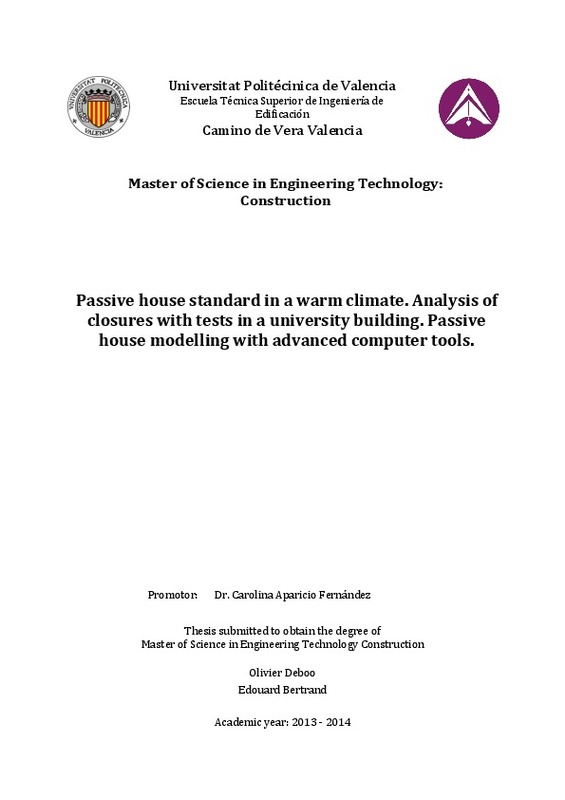JavaScript is disabled for your browser. Some features of this site may not work without it.
Buscar en RiuNet
Listar
Mi cuenta
Estadísticas
Ayuda RiuNet
Admin. UPV
Passive house standard in a warm climate : analysis of closures with tests in a university building : passive house modelling with advanced computer tools
Mostrar el registro sencillo del ítem
Ficheros en el ítem
| dc.contributor.advisor | Aparicio Fernandez, Carolina Sabina
|
es_ES |
| dc.contributor.author | Bertrand, Edouard
|
es_ES |
| dc.contributor.author | Deboo, Olivier
|
es_ES |
| dc.date.accessioned | 2014-11-27T17:37:55Z | |
| dc.date.available | 2014-11-27T17:37:55Z | |
| dc.date.created | 2014-06 | |
| dc.date.issued | 2014-11-27T17:37:55Z | |
| dc.identifier.uri | http://hdl.handle.net/10251/44952 | |
| dc.description.abstract | [EN] The objective of the thesis is to create a digital model of an existing university building with TRNSYS, an advanced simulation program, and modify it to lower the cooling and heating demand to meet the passive house standard. TRNSYS generates the temperatures as well as the heating and cooling demand that are expected in the building during one year. Therefore measurements with a weather station combined with the data from the official weather station at UPV helped obtaining annual weather data as input for TRNSYS. The Cp generator was used to calculate the wind pressure coefficients, which affect the air infiltration into the building. Also the thermal bridges in the thermal envelope were calculated using THERM as input for TRNSYS. The model is validated to check its correctness and precision by comparing it with the actual temperatures in the building. Therefore the temperatures on 2 places in the building were measured while obtaining the outside weather data. Finally modifications are imported into the model and their effect on the cooling and heating demand is analysed. The fact that the building is located in a warm climate makes the application of the passive house standard complicated. Also this fact has important influences on which modifications to apply and how to analyse them. | es_ES |
| dc.description.abstract | [ES] El objetivo del PFM es crear un modelo digital de un edificio universitario ya existente con TRNSYS, un programa de simulación avanzada, y modificarlo para reducir la demanda de refrigeración y calefacción para cumplir el estándar de casas pasivas. TRNSYS proporciona las temperaturas y también la demanda de calefacción y refrigeración que se espera en el edificio durante un año. Por otra parte, las mediciones realizadas con una estación meteorológica en combinación con los datos de la estación meteorológica oficial de la UPV sirvieron para obtener los datos meteorológicos anuales que se introdujeron en TRNSYS. El generador Cp se utilizó para calcular los coeficientes de presión del viento, que afectan a la infiltración de aire en el edificio. Por otra parte, los puentes térmicos de la envolvente se calcularon utilizando THERM como entrada para TRNSYS. El modelo fue verificado para comprobar su exactitud y precisión mediante la comparación con las temperaturas reales en el edificio. Para ello, se midieron las temperaturas en 2 zonas del edificio, al mismo tiempo que se tomaban los datos meteorológicos del exterior. Finalmente se introdujeron las modificaciones en el modelo y se analizó el efecto de estas en la demanda de refrigeración y calefacción. El hecho de que el edificio se encuentre en un clima cálido dificulta la aplicación del estándar de viviendas pasivas, por lo que este hecho es responsable de las modificaciones a aplicar y de la manera de analizarlas. | es_ES |
| dc.format.extent | 135 | es_ES |
| dc.language | Inglés | es_ES |
| dc.publisher | Universitat Politècnica de València | es_ES |
| dc.rights | Reconocimiento - No comercial - Sin obra derivada (by-nc-nd) | es_ES |
| dc.subject | Arquitectura y clima | es_ES |
| dc.subject | Eficiencia energética | es_ES |
| dc.subject | Ahorro de energía | es_ES |
| dc.subject | Arquitectura sostenible | es_ES |
| dc.subject | Simulación por ordenador | es_ES |
| dc.subject.classification | CONSTRUCCIONES ARQUITECTONICAS | es_ES |
| dc.subject.other | Máster en Edificación especialidad Tecnología de la Edificación-Màster en Edificació Especialitat Tecnologia de l'Edificació | es_ES |
| dc.title | Passive house standard in a warm climate : analysis of closures with tests in a university building : passive house modelling with advanced computer tools | es_ES |
| dc.title.alternative | El estándar de casa pasiva en un clima cálido : análisis mediante ensayos de los cerramientos de un edificio universitario : diseño de una casa pasiva con herramientas informáticas avanzadas | es_ES |
| dc.type | Tesis de máster | es_ES |
| dc.rights.accessRights | Abierto | es_ES |
| dc.contributor.affiliation | Universitat Politècnica de València. Escuela Técnica Superior de Gestión en la Edificación - Escola Tècnica Superior de Gestió en l'Edificació | es_ES |
| dc.description.bibliographicCitation | Bertrand, E.; Deboo, O. (2014). Passive house standard in a warm climate : analysis of closures with tests in a university building : passive house modelling with advanced computer tools. http://hdl.handle.net/10251/44952. | es_ES |
| dc.description.accrualMethod | Archivo delegado | es_ES |
Este ítem aparece en la(s) siguiente(s) colección(ones)
-
ETSIE - Trabajos académicos [2326]
Escuela Técnica Superior de Ingenieria de Edificación






